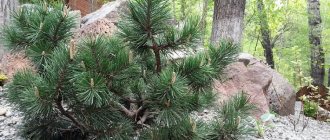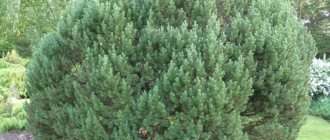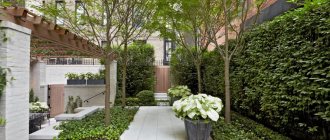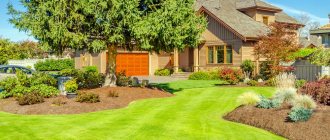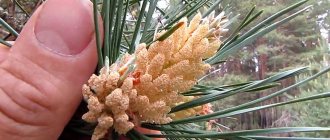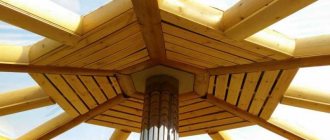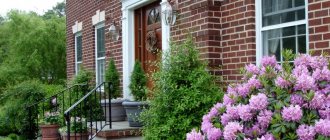Many summer residents dream of a beautiful plot with conifers. In addition to their beautiful appearance, coniferous plants have many advantages - they are considered medicinal plants because they actively release oxygen and phytoncides, absorb dust, protect from wind and the appearance of various bacteria and viruses.
Appearance
Mugus pine is a plant with hard, dark green needles, individual needles of which reach 4 cm. The needles last no more than 8 years, then they are replaced by spectacular cone-shaped cones of the same length.
The shape of the crown itself is spherical, directed upward, although there are types of mugus that are capable of spreading along the ground, expanding.
As a tree, pine is no higher than 7 m, but as a shrub it is one of the tall ones and can reach 5 m, standing out significantly against the background of lower bushes. This must be taken into account when choosing a place to plant it.
There are, however, species of this shrub that are shorter in stature, not exceeding half a meter to a meter. They are distinguished by exceptionally lush and long needles and, without exception, they all have a spherical crown shape.
Mountain pine in landscape design: pros and cons
As with any other issue, you first need to weigh the pros and cons of using this option.
Advantages of decorative mountain pine:
Mature mountain pine looks elegant and exudes a pleasant pine aroma.
- Thanks to its miniature and compact size, it can be used in a variety of landscape designs, and is especially suitable for creating an alpine slide.
- Very unpretentious in choosing soil.
- Does not require careful care.
- The shape of an adult plant is usually neat and graceful, which helps it look aesthetically pleasing, whether specially trimmed or “fluffy.”
- Differs in frost resistance.
- Almost any soil is suitable for planting.
- This evergreen plant will decorate the garden all year round.
- Creates a persistent pine scent that perfectly purifies the air.
- When planting taller varieties, you can create a small shady recreation area.
- Thanks to the large selection of mountain pine varieties, you can choose an option for landscape design in absolutely any area and in different styles.
Disadvantages of the plant: rightfully, the only disadvantage of mountain pine can be considered its relatively high price. However, it is absolutely justified.
Benefits of planting this plant
When it comes to a plant such as mountain mugus pine, the description should include not only its very attractive appearance, but also many other advantages:
- Mugus is not afraid of frost and does not suffer even at the lowest temperatures. Therefore, it can be planted even in regions with harsh winters.
- A strong root system allows mountain pine to stand even in loose soil and not be afraid of any winds.
- Thanks to its root system, mugus also easily extracts water from the soil, and therefore the owners of the site do not need to worry much about watering. In general, it easily gets used to almost any land in which it is planted.
- Mugus effectively resists most parasites, and the intervention of the owners of the site is very rarely required.
- You can safely prune mountain pine: it tolerates it very easily.
- There are different types of mugus, from tiny to large, and it's easy to find the right one.
Finally, mountain pine in landscape design can please the eye for a very long time: it continues to grow for almost a thousand years! Therefore, on the site it will certainly look fresh all the time.
How to propagate and plant correctly?
Seeds
Seed propagation is practically the only way to propagate ornamental pine, since the cuttings either do not take root at all, or the formation of rhizomes occurs too slowly and causes many problems.
- Maximum germination rate is for fresh seeds.
- No stratification required.
- Planting is done in the spring.
- Soak the seeds in water at room temperature for a day, adding a growth stimulator (Epin, Zircon, HB-101).
- Plant in a box - in moist, light soil, mixing sand and high-moor peat in equal quantities to a depth of 1 cm.
- As soon as the sprouts hatch, immediately expose the box to the light. There should be no shadow.
- Spray with fungicidal solutions once every 2 weeks, since young pines in the first year of life are highly susceptible to fungal diseases.
Ornamental pine seedlings grown from seeds can be planted in the ground in the fall.
Landing in the ground
If you plan to grow a pine tree in a pot, it is better to plant the seedling in it immediately. Ideal varieties for this are Blue Shag, Makopin, Pug, Gnome, and Bosnian. In other cases, seedlings are transferred directly to the ground.
- There must be a lump of earth on the seedling. If the roots are exposed, the tree will be sick for a long time and may not take root.
- A sunny location with deep groundwater is selected.
- A drainage layer of crushed stone or broken brick 10 cm deep is required.
- Next, nutrient soil is poured into the planting hole, for the preparation of which coarse sand, humus and turf are mixed.
- The seedling is placed in a planting hole and covered with a nutrient mixture.
- The root collar should be level with the ground.
- Water generously.
Texture
A freshly cut trunk has a pinkish core. The color is determined by the location of the tree, its species, age, and structural features. Pine wood has a uniform structure, is characterized by low elasticity and high strength. The fibers are straight, this applies to almost all types of pine. According to its texture, experts classify it as a medium-coarse rock.
Mechanical properties
Pine is a medium-density and medium-hard wood species. And its strength indicator is high. When compressed along the fibers, the tensile strength is about 440 g/cm2. It doesn't bend well. The ability to resist splitting is low. Moisture and breathability are high. However, different breeds have different mechanical properties. Northern pine is considered the best. Its annual rings are located at a minimum distance from each other - no more than 2 mm, so it is less loose and more durable. Her shrinkage is lower. Northern pine is less susceptible to cracking.
Physical properties of pine
Pine is a tall tree with a straight slender trunk 30-50 m high and 70-100 cm in diameter. Some specimens reach 70 m in height. This is a fairly fast-growing tree; in a year it grows up to 1 m. However, pine lives for 300-400 years. The color of pine wood varies from white-yellow to orange-brown. It depends on the species, location and age of the tree. During long-term storage, wood darkens.
Popular articles Tangerine tree - home care
The sapwood is lighter in color than the heartwood. The wood has resin ducts. The humidity of a growing tree is about 33% in the core, and 110-115% in the sapwood. The upper part of the tree has a higher sapwood moisture content. In the core, the humidity of the upper and lower parts is the same. The trunk of a freshly cut pine tree has a moisture content of approximately 85%.
The high moisture permeability of pine wood allows it to be quickly and easily impregnated with protective compounds - antiseptics, etc. These properties of pine wood are taken into account when using it in construction
An important characteristic is also the low tendency to warping and cracking during drying.
Reproduction
Many people are engaged in the propagation of mountain pine. There are several ways to do this: cuttings, seeds, and grafting. Each of them has its own characteristics.
Using seeds
The selected seeds must be germinated in separate containers or sown directly in open ground. Before this they will need stratification. It is best to plant seeds in the spring.
Using cuttings
It is better to take cuttings from annual seedlings. They are separated with the bark. To begin with, the finished material must be soaked for 10-11 hours in a specially purchased growth accelerator. After this, they need to be kept in clean water for three days. Then you can start planting in open ground. Those cuttings that were planted in the autumn should take root throughout the year, but cuttings planted in the spring will fully take root after 180 days.
By vaccination
For the graft to work, the rootstock must be well developed. Most often, seedlings that are up to 5 years old are chosen for this purpose. This process is possible both in open ground and on a trunk. The scions must be prepared in late autumn and placed either in the cellar or in the refrigerator, after moistening the gauze in which they must be wrapped. The vaccination itself can be done in both spring and autumn. However, in the spring they are better accepted. Moreover, in this way all the qualities of pine are best conveyed.
Photos of coniferous compositions for the garden
Sources
- https://dizlandshafta.ru/ozelenenie/rastenija/hvojnye-v-sadu/
- https://jamaster.ru/luchshie-xvojnye-rasteniya-dlya-sada/
- https://Dacha2U.ru/dizayn/kompozitsii-iz-hvoynyh
- https://ogorodum.ru/klumba-s-hvojnymi.html
- https://roomester.ru/landshaft/hvojnye-v-landshaftnom-dizajne-dachnogo-uchastka.html
- https://design-homes.ru/landshaft/khvojnye-kompozitsii
- https://moi-ogorod.ru/hvoyniki-v-landshaftnom-dizayne-rasteniya-dlya-sada-i-dachi-gotovye-kompozitsii-pered-domom-s-tuyami-i-mozhzhevelnikom-41-foto/
- https://www.ivd.ru/dizajn-i-dekor/landsaft/kak-garmonichno-vpisat-hvojniki-v-landshaftnyj-dizajn-sada-sovety-i-60-foto-65211
- https://b-online.ru/landshaftnyy-dizayn/miksborder-iz-hvoynyh-i-kustarnikov-gotovye-shemy-izumitelnye-idei-s-foto.html
- https://grounde.ru/miksborder-iz-hvoynyh-i-kustarnikov-shemy.html
- https://sadomerok.ru/miksborder-iz-hvojnyh.html
- https://greenland61.ru/rasteniya/landshaft-s-tuyami-i-mozhzhevelnikom.html
- https://landshaftdesign.info/luchshie-xvojnye-rasteniya-dlya-sada/
Areas of application of pine wood
Pine is the most popular lumber among all coniferous species. The scope of its application in the national economy is extensive. It is distinguished by its reliability and low cost compared to deciduous wood - oak, ash, etc. It is actively used in construction for the construction of residential buildings, bathhouses, and outbuildings. The tall and straight pine trunk has few knots. Therefore, it is suitable for the production of rounded logs and beams with a small amount of waste.
Resistance to rotting and damage by parasites distinguishes it favorably from spruce. However, for the construction and interior decoration of baths, it is preferable to use spruce, which has less resin.
The strength of pine wood allows it to be used to make load-bearing structures of buildings, beams, rafters, floors, frames, wooden piles, window frames, etc. The low thermal conductivity of pine wood ensures maintaining a comfortable temperature in the room. Pine buildings also have a sufficient level of sound insulation, and no additional work is required for this purpose. Pine boards are also used for interior finishing work, flooring, etc.
Pine lumber is used in the production of furniture. Frames are mainly made from them, which are covered with veneer of other types of wood. The low density of this material allows you to decorate furniture with mosaics and carved patterns. Such furniture is reliable and meets environmental requirements.
Pine is used in shipbuilding, chemical and paper industries, railway construction, etc. Pine needles are raw materials for the production of medicines and biological additives.
Caring for coniferous composition
A properly organized flower bed of conifers and plants that feel good next to them does not require special care, but without care it quickly loses its attractive appearance.
To maintain the health and beauty of the landscape composition it is necessary:
- watering once every two weeks;
- spraying once a week;
- fertilizing with mineral fertilizers once a season;
- regular weed removal;
- mulching with bark, stone chips, gravel;
- sanitary pruning in the fall, throughout the year with strong growth;
- preventive treatment against pests and fungi;
- preparation for winter (ample addition of sawdust, leaves, pine needles to the tree trunks).
A coniferous flowerbed is an opportunity to try yourself as a landscape designer, to decorate a small piece of forest on your own plot. The main thing is not to get carried away; the rules for creating a flower garden, combinations of plants according to the conditions of growth and care will have to be followed so that the flower garden with conifers brings joy.
Diseases
Rust. A fungal disease that damages wood, bark on skeletal branches and shoots. In places where reddish growths form, the conifer dies and the needles fall off.
Popular articles All about juniper Meieri Compacta
Treatment is carried out by twice irrigating the crown with Hom, Skor or Ridomil gold. Before treatment, all diseased parts are cut out.
Take regular disease prevention measures
Brown Schutte. This sore develops in early summer. First, the fungus damages the young growth and needles. Over time, they turn yellow, later acquire a brown color, and crumble. At the end of August, the crown becomes covered with small black spots.
- Only neglected specimens can be cured - cut out all infected areas, then collect carrion, irrigate the above-ground part and soil with a solution of copper sulfate or Bordeaux mixture.
- Heavily infected ones are dug up and burned.
Gum treatment. This usually occurs on wood damaged by frost damage.
In the spring, when the threat of the last frost has passed, the places where the gum leaks out are cleaned. Then it is treated with a solution of copper sulfate. After drying, I cover it with garden varnish. Over the summer, the wounds should heal.
Pests and their control
Spider mite. It entwines needles, young shoots, and buds with a fine web and sucks out the juices from them, resulting in their yellowing and drying out.
You can get rid of parasites with the help of acaricides - Actellica or Aktara.
Aphid. This insect settles in colonies, multiplies rapidly, and feeds on the tissues of leaves and twigs.
- At the initial stage of the lesion, gentle means are used - ash-soap solution, tobacco or garlic infusion.
- Neglected conifers must be treated twice with Karbofos or Fundazol every 7 days.
Shield. Causes great damage to larch. It sticks to shoots, leaves, buds, sucks out the juice, as a result of which the damaged parts die.
The drug Decis will help to destroy it - irrigate the crown and trunk area twice with an interval of 10 days.
